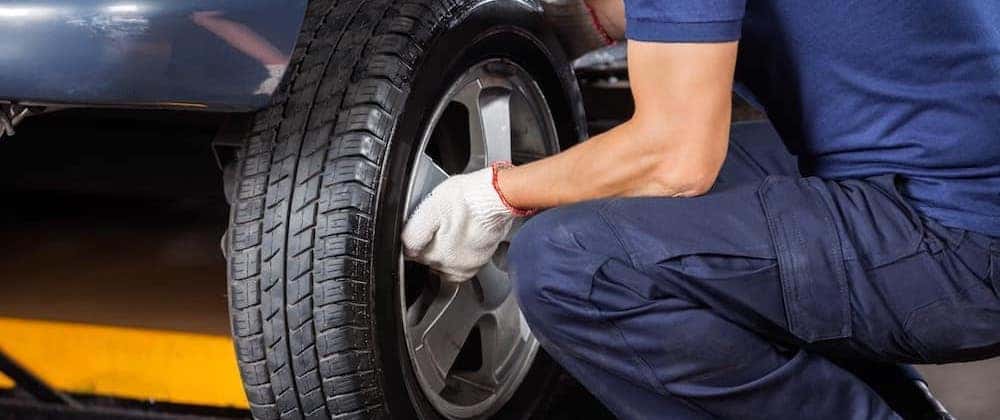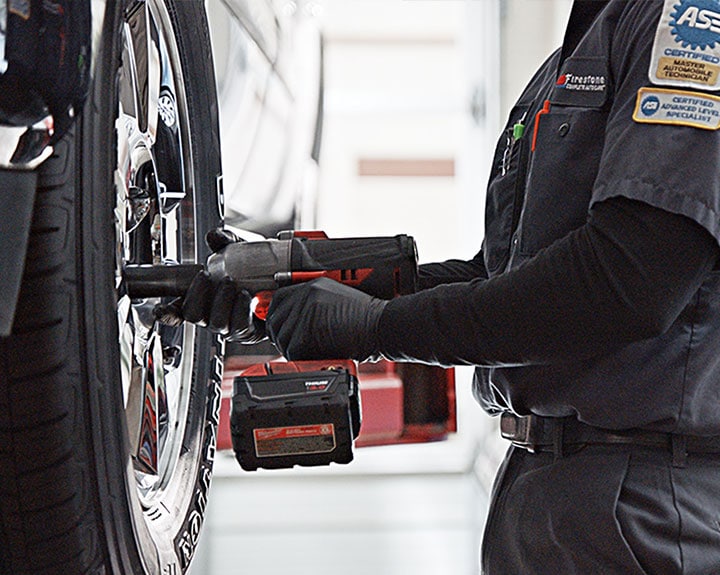Balancing and rotating tires typically takes around 45 minutes to 1 hour. During this process, the tires are removed, and their position on the wheel is changed to ensure even wear.
Additionally, the wheels are balanced to minimize vibrations while driving. Proper tire maintenance is essential for a smooth and safe driving experience. One crucial aspect of tire care is balancing and rotating them. But how long does this process actually take?
In most cases, balancing and rotating tires can be completed within 45 minutes to 1 hour. This straightforward procedure involves removing the tires, changing their position on the wheel to promote even wear, and balancing the wheels to minimize vibrations.
We will delve into the details of tire balancing and rotating, exploring why it is necessary and how long it typically takes. So, let’s get started and unravel the mysteries behind this vital tire maintenance task.

Credit: www.scottevansnissanusa.com
Understanding Tire Balancing
Tire balancing is an essential maintenance procedure that involves equalizing the weight distribution of a tire and wheel assembly. This process ensures that all tires rotate smoothly and evenly, improving driving performance and safety. If wheels are improperly balanced, it can lead to vibrations, uneven tread wear, and a less comfortable ride.
What Is Tire Balancing?
Tire balancing is the process of adjusting the weight distribution of a tire and wheel assembly to ensure proper alignment and smooth rotation. When a tire is mounted on a wheel, it may not be perfectly balanced due to slight variations in weight distribution.
To rectify this, small weights are strategically placed on the wheel to counterbalance any inconsistencies, resulting in a smoother ride.
Why Is Tire Balancing Important?
Proper tire balancing plays a vital role in ensuring a safe and comfortable driving experience. When tires are not balanced, an uneven weight distribution causes vibrations that can be felt through the steering wheel or vehicle body.
These vibrations can not only compromise ride comfort but also lead to premature wear on suspension components. Additionally, imbalanced tires can affect steering control and increase tire damage.
Signs That Your Tires Need To Be Balanced
It’s important to recognize the signs that your tires may need balancing to address the issue promptly. Some common indicators include:
- Vibrations: If you feel vibrations in your steering wheel or through the seat while driving at higher speeds, it may indicate an imbalance.
- Uneven tread wear: Irregular wear patterns on your tires, such as cupping or scalloping, can suggest the need for balancing.
- Pulling to one side: If your vehicle tends to pull to one side while driving, it could be a sign of an imbalanced tire.
- Noise: Unusual noises, like thumping or humming, can occur when tires are imbalanced, especially at higher speeds.
If you notice any of these signs, it’s crucial to have your tires inspected and balanced by a professional technician. Regular tire balancing not only improves comfort and handling but also extends the lifespan of your tires, saving you money in the long run.

Credit: medium.com
The Tire Balancing Process
In order to ensure a safe and smooth ride, it is important to regularly balance and rotate your tires. Tire balancing involves correcting any imbalances in weight distribution across the tire and wheel assembly.
This process is crucial as it helps minimize vibrations and ensures even tire wear. Here’s a step-by-step guide on how the tire balancing process is typically carried out:
Step 1: Inspection
Before starting the tire balancing process, a thorough inspection is conducted to check for any visible damage or signs of wear on the tires. This helps identify any potential issues that need to be addressed before balancing the tires.
Step 2: Mounting The Wheel On The Balancing Machine
Once the tires pass the inspection, they are removed from the vehicle and mounted onto a specialized balancing machine. The machine securely holds the wheel in place, allowing for precise measurements and adjustments to be made.
Step 3: Balancing The Tire
The balancing machine is then activated, spinning the wheel at high speed. As the wheel rotates, the machine measures any imbalances in weight distribution. These imbalances can be caused by uneven tire wear, manufacturing variances, or the presence of any foreign objects.
Step 4: Adjusting Tire Weight
Based on the measurements obtained from the balancing machine, small weights are added or removed from specific areas of the wheel. These weights help counterbalance the imbalances and ensure that the tire and wheel assembly spins evenly.
Step 5: Remounting The Wheel On The Vehicle
After the tire has been balanced, it is carefully remounted onto the vehicle. During this step, it is important to ensure that the wheel is aligned correctly and securely fastened to the wheel hub. This ensures optimal performance and safety on the road.
By following these steps, the tire balancing process helps to eliminate vibrations, increase tire longevity, and enhance the overall driving experience.
Regular tire balancing, along with proper tire rotation, can help maintain optimal tire performance and ensure a safer and smoother ride for you and your passengers.
The Tire Rotation Process
The tire rotation process typically takes around 30-60 minutes to complete. During this time, each tire is balanced and rotated to ensure even wear and optimal performance. This procedure is essential to extend the lifespan of your tires and maintain a safe driving experience.
What Is Tire Rotation?
Tire rotation is the process of moving the tires of a vehicle from one position to another. This is done to ensure even wear and extend the overall life of the tires. It involves swapping tires between the front and rear axles, as well as from the left to the right side and vice versa.
Why Is Tire Rotation Important?
Tire rotation is important for several reasons. Firstly, it promotes even tire wear, as the tires on different positions of the vehicle may experience different levels of stress. By regularly rotating the tires, you can distribute the wear evenly and prevent premature damage.
Secondly, tire rotation helps to maintain proper traction and handling. Uneven tread wear can cause imbalance and lead to a decrease in the performance of your vehicle. By rotating the tires, you can ensure optimal grip and control, especially during turns or in wet or icy conditions.
Finally, tire rotation can also help to improve fuel efficiency. When the tires are properly aligned and balanced, the vehicle can roll more easily and smoothly, resulting in less resistance and lower fuel consumption.
Types Of Tire Rotation Patterns
There are several tire rotation patterns commonly used:
- Front-to-Rear: This involves moving the front tires straight back to the rear axle, and the rear tires to the front axle on the same side. This pattern is most commonly used for vehicles with non-directional tires.
- X-Pattern: This pattern is used for vehicles with directional or asymmetric tires. The front tires are crossed and moved to the opposite rear positions, while the rear tires are moved straight forward to the corresponding front positions.
- Rearward Cross: This pattern is used for vehicles with directional or asymmetric tires that cannot be crisscrossed. The rear tires are moved straight forward to the front positions, while the front tires are moved straight back to the corresponding rear positions.
Step-by-step Guide To Tire Rotation
Here is a step-by-step guide to tire rotation:
Step 1: Prepare your vehicle by parking it on a flat, stable surface and engaging the parking brake.
Step 2: Identify the type of tire rotation pattern recommended for your vehicle.
Step 3: Loosen the lug nuts on all the tires using a lug wrench or a suitable tool.
Step 4: Use a car jack to lift one corner of the vehicle at a time, following the manufacturer’s instructions.
Step 5: Remove the lug nuts completely and take off the wheel by pulling it straight off the hub.
Step 6: Place the wheel in its new position according to the rotation pattern, ensuring any directional or asymmetric tires are facing the correct direction.
Step 7: Carefully hand-tighten the lug nuts on the wheel in a crisscross pattern.
Step 8: Lower the vehicle using the car jack and repeat the process for the remaining tires.
Step 9: Once all the tires have been rotated, use a torque wrench to tighten the lug nuts to the manufacturer’s recommended specifications.
Step 10: Double-check that all lug nuts are securely tightened, and then lower the vehicle completely.
Step 11: Take a short test drive to ensure the vehicle feels balanced and the tires are functioning properly.
Remember to consult your vehicle’s owner manual or seek professional assistance if you are unsure about the recommended rotation pattern or any step of the process.
Regular tire rotation, typically performed every 5,000 to 7,000 miles or as advised by the manufacturer, is essential for maintaining tire performance and extending their lifespan.

Credit: www.firestonecompleteautocare.com
Frequently Asked Questions On How Long Does It Take To Balance And Rotate Tires?
How Long Does It Take To Balance All 4 Tires?
Balancing all 4 tires typically takes about 30-45 minutes.
Is It Ok To Rotate Tires Without Balancing Them?
No, it is not advisable to rotate tires without balancing them. Balancing ensures even weight distribution, reducing vibrations and extending tire life. Neglecting balancing can lead to uneven wear, reduced performance, and potential safety hazards. Always balance tires when rotating them to maintain optimal performance.
How Long Does Tire Balancing Last?
Tire balancing usually lasts between 3,000 and 6,000 miles. Regular maintenance is key to ensuring balance and maximizing tire lifespan.
How Long Does It Take To Rotate Tires At Discount Tire?
Discount Tire typically takes around 30 to 45 minutes to rotate tires.
Conclusion
The time it takes to balance and rotate tires can vary depending on various factors such as the complexity of the job and the availability of equipment. However, it is generally recommended to have this maintenance performed at least once a year or every 6,000-8,000 miles.
By regularly balancing and rotating your tires, you can ensure a smoother, safer ride and prolong the life of your tires. So, don’t overlook this essential maintenance task for your vehicle.
